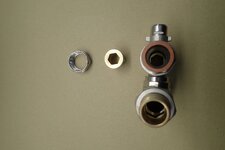WindyMiller
Mechanical
- Nov 4, 2024
- 2
Hi all
I am investigating a series of leaks from union type joints on a circulating hot water system in an apartment block. Operating pressure varies with the height of the building but is in the range 5 to 10 bar (70 to 140 psi). Water temperature is about 80 deg C (175 deg F). Nominal joint diameter is about 20mm (3/4 inch).
The joints are essentially flat face with a fibre gasket and the leaks are happening because the gasket is being pushed out to one side. One of the faces is completely flat, but the other has a groove machined into it. This is not something that I have seen before, but I envisage that the groove is intended to create a slight ridge on the mating face of the compressed gasket to reduce the likelihood of radial movement of the gasket. I have been trying to find a design standard for this type of face, so that I can check that the dimensions of the groove are appropriate to the dimensions of the 'lands' to either side, so far without success.
Is anybody aware of any design standards for this type of joint (preferably UK / European)?
Thanks for reading this.
Chris
I am investigating a series of leaks from union type joints on a circulating hot water system in an apartment block. Operating pressure varies with the height of the building but is in the range 5 to 10 bar (70 to 140 psi). Water temperature is about 80 deg C (175 deg F). Nominal joint diameter is about 20mm (3/4 inch).
The joints are essentially flat face with a fibre gasket and the leaks are happening because the gasket is being pushed out to one side. One of the faces is completely flat, but the other has a groove machined into it. This is not something that I have seen before, but I envisage that the groove is intended to create a slight ridge on the mating face of the compressed gasket to reduce the likelihood of radial movement of the gasket. I have been trying to find a design standard for this type of face, so that I can check that the dimensions of the groove are appropriate to the dimensions of the 'lands' to either side, so far without success.
Is anybody aware of any design standards for this type of joint (preferably UK / European)?
Thanks for reading this.
Chris


